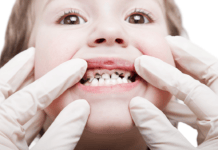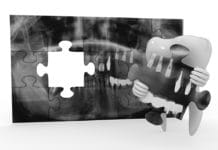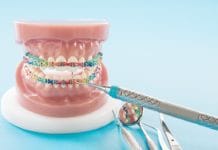Disclosure: This quiz is sponsored content from Designs for Vision as part of our sponsored partner program.
Get a FREE, no-obligation 45-day trial of any pair of loupes from Designs for Vision here.
Now let’s test your ergonomics and musculoskeletal disorder prevention knowledge!
Test Your Ergonomics and Musculoskeletal Disorder Prevention Knowledge
1. The areas most affected by musculoskeletal disorders and pain experienced by dental professionals are the neck, shoulder, lower back, and upper back.
Musculoskeletal disorders (MSDs) are a group of diseases that impact the musculoskeletal system and various structures, such as joints, bones, nerves, blood vessels, muscles, ligaments, tendons, and intervertebral discs. They can arise from one or several injuries which result in sensory disturbances or pain. The areas most affected by MSDs and pain experienced by dental professionals are the neck (58.5%), lower back (56.4%), shoulder (43.1%), and upper back (41.1%). MSDs can be temporary or chronic - chronic is more common, representing 40% of all chronic diseases.
Lietz, J., Ulusoy, N., Nienhaus, A. Prevention of Musculoskeletal Diseases and Pain Among Dental Professionals Through Ergonomic Interventions: A Systematic Literature Review. Int. J Environ Res Public Health. 2020; 17(10): 3482. https://www.mdpi.com/1660-4601/17/10/3482
2. Which of the following does dental hygiene rank first in prevalence among U.S. occupations?
Among U.S. occupations, dental hygiene ranks first in prevalence for carpal tunnel syndrome, musculoskeletal disorders (MSDs), and upper extremity disorders. The symptoms of carpal tunnel syndrome have been reported by approximately 45% of dental hygienists. Often developing within just a few years of clinical practice, 10% of hygienists are medically diagnosed with carpal tunnel syndrome. One study reported that within a 12-month period, 64-96% of hygienists experienced symptoms of MSDs, which adversely affected these individuals' quality of life and career longevity.
Other dental professionals are commonly affected by these disorders, too. Two-thirds of all dental professionals report occupational musculoskeletal pain, which leads to many only working part-time. MSDs adversely affect clinical effectiveness, productivity, and work satisfaction. Almost a third of dentists are forced to retire early because of MSDs.
Lin, K., Wink, C., Dolan, B., et al. A Novel Ergonomic Curette Design Reduces Dental Prophylaxis-Induced Muscle Work and Fatigue. Dentistry Journal. 2023; 11(12): 272. https://www.mdpi.com/2304-6767/11/12/272
3. Preventing musculoskeletal disorders through a neutral, balanced working posture includes a forward head tilt of ____ degrees or less.
Maintaining a neutral, balanced working posture is a significant factor in preventing musculoskeletal disorders. One of the most frequently observed incorrect postures in dental practitioners is extreme forward head tilt and overstretched neck. Forward-head tilt and rounded-shoulder postures increase loads on the upper neck muscles and spinal vertebral discs.1 A balanced working posture includes the head positioned on top of a neutral spine with a forward head tilt of 15 to 20 degrees or less.2
The best way to maintain a balanced head position is through preventive ergonomic measures, such as using magnification loupes.3 One of the ergonomic benefits of loupes, such as Designs for Vision, is their ability for a clinician to maintain an average head tilt of about 20 degrees. However, this can only be achieved if the declination angle of the magnification loupes' lens is finely measured and specifically adjusted by a trained manufacturer's representative for the clinician using them. Otherwise, a greater downward tilt of the head may occur, thus reducing the ergonomic benefits of loupes.4
- De Sio, S., Traversini, V., Rinaldo, F., et al. Ergonomic Risk and Preventive Measures of Musculoskeletal Disorders in the Dentistry Environment: An Umbrella Review. PeerJ. 2018; 6: e4154. https://doi.org/10.7717/peerj.4154
- Smilyanski, I. (2023). Patient Reception and Ergonomic Practice. In L. D. Boyd & L. F. Mallonee, Wilkins' Clinical Practice of the Dental Hygienist (14th ed., pp. 121-132). Jones & Barlett Learning.
- Kaur, H., Pant, V.A., Gupta, V. Magnification in Dental Ergonomics - A Comprehensive Review. Advances in Bioscience and Clinical Medicine. 2022; 10(1): 21-25. https://www.researchgate.net/publication/360150127_Magnification_in_Dental_Ergonomics_-_A_Comprehensive_Review
- Pazos, J.M., Regalo, S.C.H., de Vasconcelos, P., et al. Effect of Magnification Factor by Galilean Loupes on Working Posture of Dental Students in Simulated Clinical Procedures: Associations Between Direct and Observational Measurements. PeerJ. 2022; 10: e13021. https://www.ncbi.nlm.nih.gov/pmc/articles/PMC8918149/
4. The addition of a headlight to loupes has no ergonomic, visual acuity, or depth perception benefits.
The pupil of the eye constricts in response to brightness, increasing the depth of field (the range of distances at which vision is sharp) and visual acuity (sharpness of vision and ability to discriminate fine detail).1 The addition of a headlight to loupes increases light intensities up to four times that of traditional overhead lamps.2 The higher the brightness, called luminance, the closer a structure is perceived to be.3
The ergonomic benefits of loupe headlights include aligning closely to the line of vision and significantly reducing shadowing, resulting in the reduction of neck and shoulder flexion.2 Headlights also prevent the continual need to adjust the overhead light during treatment, thus reducing repetitive motions and awkward postures that increase the risk of musculoskeletal disorders.4,5
- Mathot, S. Pupillometry: Psychology, Physiology, and Function. Journal of Cognition. 2018; 1(1): 16. https://journalofcognition.org/articles/10.5334/joc.18
- Bonilla, E.D., Mishail, D., Zhang, E., et al. Hallmark of Dentistry: The Evolution and Benefits of the Dental Magnifying Loupe. Journal of the California Dental Association. 2023; 51(1): 2176579. https://www.tandfonline.com/doi/full/10.1080/19424396.2023.2176579
- Reissis, A., Yoo, S. Clarkson, M.J., Thompson, S. The Effect of Luminance on Depth Perception in Augmented Reality Guided Laparoscopic Surgery. Proc SPIE Int Soc Opt Eng. 2023; 12466: 12466-51. https://www.ncbi.nlm.nih.gov/pmc/articles/PMC7614313/
- Hayes, M. J. (2020). Ergonomics and Work-Related Musculoskeletal Disorders. In D. M. Bowen & J. A. Pieren, Darby and Walsh Dental Hygiene: Theory and Practice (5th ed., pp. 143-153). Elsevier.
- Jodalli, P.S., Kurana, S., Shameema, R.M., et al. Posturedontics: How Does Dentistry Fit You? Journal of Pharmacy and BioAllied Sciences. 2015; 7(Suppl 2): S393-S397. https://www.ncbi.nlm.nih.gov/pmc/articles/PMC4606627/
5. Ergonomic instrument design can decrease the risk of musculoskeletal disorders by reducing the need for excessive pinch force. Hand instruments with smaller handle diameters reduce hand muscle load and pinch force.
Pinch force is the force exerted between the thumb and forefinger when pinching or gripping. Excessive pinch force is associated with an increased risk of musculoskeletal disorders. Lightweight hand instruments with larger handle diameters reduce hand muscle load and pinch force. Compared to a hexagonal handle, a round handle will reduce muscle force and compression. Diamond-shaped or criss-cross patterned knurled handles also reduce pinch force due to increasing tactile sensitivity resulting from the knurl.
Jodalli, P.S., Kurana, S., Shameema, R.M., et al. Posturedontics: How Does Dentistry Fit You? Journal of Pharmacy and BioAllied Sciences. 2015; 7(Suppl 2): S393-S397. https://www.ncbi.nlm.nih.gov/pmc/articles/PMC4606627/
6. Using dull instruments that deviate from their original design causes the clinician to apply additional force, resulting in which of the following?
Musculoskeletal disorders include repetitive strain injuries, which are painful injuries to the body caused by overuse or repetitive tasks. Sharp instruments are essential in decreasing fatigue and stress on the clinician's hand, wrist, arm, and shoulders, which cause repetitive strain injuries.
Using dull instruments that deviate from their original design causes the clinician to apply additional force. This results in excess stroke repetitions, tightened grasp, and increased lateral pressure applied during instrumentation. Instruments with cutting edges should be kept properly maintained and sharp throughout the entire procedure.
Hayes, M. J. (2020). Ergonomics and Work-Related Musculoskeletal Disorders. In D. M. Bowen & J. A. Pieren, Darby and Walsh Dental Hygiene: Theory and Practice (5th ed., pp. 143-153). Elsevier.
7. The use of ultrasonic instruments significantly reduces repetitive motions of the hand, wrist, and forearm. Unlike hand instruments, ultrasonic insert tips do not wear over time and don't need to be replaced.
Hand instrumentation requires numerous repetitive strokes and significant lateral pressure and force compared to ultrasonic instrumentation. Repetitive hand, wrist, and forearm motions that may lead to repetitive strain injuries are significantly reduced with the incorporation of ultrasonic instruments. The lateral pressure and force necessary using ultrasonics for biofilm or minimal calculus removal are similar to, if not less than, the force applied with an exploratory stroke. The maximum lateral pressure and force for removing larger deposits is slightly greater than that used with an exploratory stroke.1
Ultrasonic insert tips wear with use and become reduced in length. A loss of 1 mm reduces efficacy by 25%, while a loss of 2 mm reduces efficacy by 50%. This loss of efficacy requires increased time for instrumentation, more strokes, and excessive lateral pressure and force while scaling.2 A clinician should monitor the wear of ultrasonic insert tips often and use the wear guide supplied by the manufacturer to help monitor the need for replacement.1
- George, M. D. (2020). Ergonomics and Work-Related Musculoskeletal Disorders. In D. M. Bowen & J. A. Pieren, Darby and Walsh Dental Hygiene: Theory and Practice (5th ed., pp. 456-474). Elsevier.
- Lea, S.C., Landini, G., Walmsley, A.D. The Effect of Wear on Ultrasonic Scaler Tip Displacement Amplitude. J Clin Periodontol. 2006; 33: 37-41.
Get a FREE, no-obligation 45-day trial of any pair of loupes from Designs for Vision here.
Get a FREE, no-obligation 45-day trial of any pair of loupes from Designs for Vision here.












